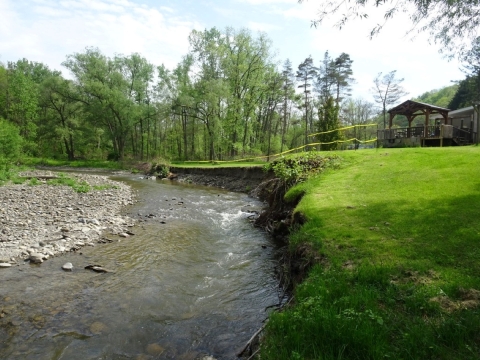What We Do
Our projects include:
- Wetlands
- Grasslands
- Endangered Species Habitat
- Stream Bank Fencing
- Stream Bank Stabilization
- In-stream Restoration
- Fish Spawning
- Marshes
- Outdoor Classrooms for Educational Facilities
- Invasive Species Projects
The amount of interest by private landowners to restore wildlife habitat on their land continues to increase in New York State. There are over 2100 landowners enrolled in the program with at least 50 new contacts each year. The Partners for Fish and Wildlife program continues to expand its restoration capabilities. Fish spawning marshes are being restored on the St. Lawrence River. Invasive species projects, such as purple loosestrife removal, continue to be a priority for the program too.
Our Projects and Research
Young Forest Habitat
A relatively new project-type for the Partners, the establishment of young forest habitat in New York is a beneficial endeavor for local wildlife. In the last 15 years the Partners have been able to establish about 150 acres of young forest habitat on private lands with organization and assistance from the Upper Susquehanna Conservation Alliance, the New York State Department of Environmental Conservation (NYSDEC), and the National Wildlife Refuge System.
Converting older growth forest into young forest habitat provides wildlife species such as the American woodcock, golden winged warbler, ruffed grouse, and New England cottontail rabbit with important habitat to help stabilize their populations. By removing trees (between 2-4 inches in diameter) from a property new growth can then occur. Trees are either felled and left as supplemental habitat features or mulched using forest re-mulching equipment. This creates a layer of mulch in the forest promoting rich soil.
Young forest habitat projects are meant to be ongoing since forests are only considered “young” between 0-10 years old. If you are interested in learning more or implementing this type of project on your property, please contact the Partners.
Riparian Restorations by Fencing
Typically, riparian riparian
Definition of riparian habitat or riparian areas.
Learn more about riparian fencing involves constructing electric or non-electric fence along streams to limit the access of cattle or other livestock to waterways. Creating a buffer zone of 30 feet from rivers or streams is beneficial in many ways. Some of these benefits include:
Improved fish and wildlife habitat
Improved herd health
Reduced run-off and sediments
Improved water quality
Stream bank stabilization
Provide nesting cover within buffer zone
In-stream Restoration
In-stream, or fluvial geomorphic, restoration involves the restoration of streams utilizing natural design. Historic approaches to stream restoration included building elaborate structures, removing debris, dredging, or installing riprap. These approaches create more problems downstream and fail after only a few years.
Fluvial geomorphic restoration begins with extensive data collection and uses strongly engineered design to return natural flows and a more natural appearance to degraded streams. These engineered designs typically include placing large rocks and/or logs to achieve appropriate flow.
The Partners program also implements aquatic organism passage (AOP) projects, like installing culverts. Use of these types of restoration is expected to continue to grow rapidly in New York.
Wetland Restoration
Of the 221 million acers of wetlands that once existed across the United States in the late 1700s, less than half remain today. Of those remaining wetlands 75% are on privately owned lands. For this reason, the Partners for Fish and Wildlife program has, and will continue to, bring focus to protecting and restoring wetland habitats.
A defined wetland must meet certain criteria: it must have the presence or potential for water (hydrology), the presence of water-loving (hydric) soils, and the presence of wetland (aquatic) plants. The most productive wetlands are those that have an average depth of about 18 inches and have an approximate ratio of 1:1 (open water : vegetation). The Partners program is not able to construct deep, open water ponds to be used for recreation or non-wildlife related activities.
Grassland Restoration
Grasslands provide habitat for many different species of wildlife. Recent studies have shown a decline in grassland nesting birds, with one of the causes being loss of habitat. With the disappearance of grasslands across New York, the Partners for Fish and Wildlife, with the collaboration of private landowners, have been working diligently to restore this habitat.
The two main types of grassland restoration activities that the program focuses on are mowing and seeding. Mowing is a cost-effective approach taken on grasslands that are in the early stages of reverting to brush and forest. For sites where woody vegetation is smaller in diameter and is not dense the mowing is completed using a tractor and “brush-hog” type mower. For larger and more densely vegetated sites, a Hydro-Ax with a rotary-ax machine is used. Seeding as a restoration activity involves planting areas with a mix of native grasses and forbs.
Other
The Partners for Fish and Wildlife program is very unique in that the possibilities for providing private landowners assistance with various projects in nearly endless. Although restoration is the primary purpose of the program, other projects are also developed to protect and enhance fish, wildlife, plants, and their associated habitats.

